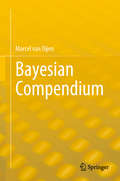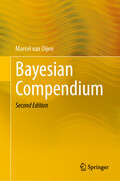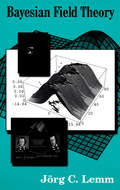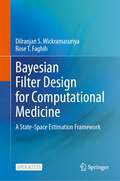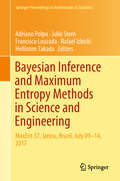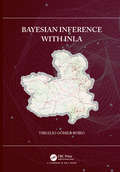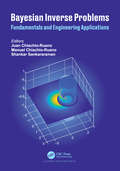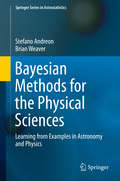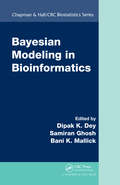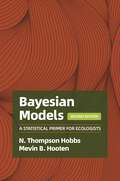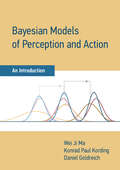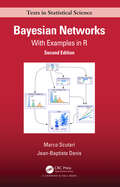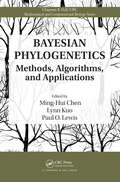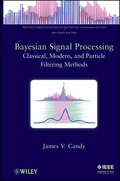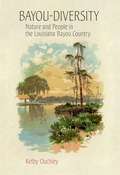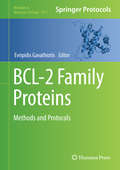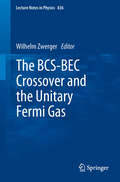- Table View
- List View
Bayesian Cognitive Modeling
by Michael D. Lee Eric-Jan WagenmakersBayesian inference has become a standard method of analysis in many fields of science. Students and researchers in experimental psychology and cognitive science, however, have failed to take full advantage of the new and exciting possibilities that the Bayesian approach affords. Ideal for teaching and self study, this book demonstrates how to do Bayesian modeling. Short, to-the-point chapters offer examples, exercises, and computer code (using WinBUGS or JAGS, and supported by Matlab and R), with additional support available online. No advance knowledge of statistics is required and, from the very start, readers are encouraged to apply and adjust Bayesian analyses by themselves. The book contains a series of chapters on parameter estimation and model selection, followed by detailed case studies from cognitive science. After working through this book, readers should be able to build their own Bayesian models, apply the models to their own data, and draw their own conclusions.
Bayesian Compendium
by Marcel van OijenThis book describes how Bayesian methods work. Its primary aim is to demystify them, and to show readers: Bayesian thinking isn’t difficult and can be used in virtually every kind of research. In addition to revealing the underlying simplicity of statistical methods, the book explains how to parameterise and compare models while accounting for uncertainties in data, model parameters and model structures. How exactly should data be used in modelling? The literature offers a bewildering variety of techniques and approaches (Bayesian calibration, data assimilation, Kalman filtering, model-data fusion, etc). This book provides a short and easy guide to all of these and more. It was written from a unifying Bayesian perspective, which reveals how the multitude of techniques and approaches are in fact all related to one another. Basic notions from probability theory are introduced. Executable code examples are included to enhance the book’s practical use for scientific modellers, and all code is available online as well.
Bayesian Compendium
by Marcel van OijenThis book describes how Bayesian methods work. Aiming to demystify the approach, it explains how to parameterize and compare models while accounting for uncertainties in data, model parameters and model structures. Bayesian thinking is not difficult and can be used in virtually every kind of research. How exactly should data be used in modelling? The literature offers a bewildering variety of techniques (Bayesian calibration, data assimilation, Kalman filtering, model-data fusion, …). This book provides a short and easy guide to all these approaches and more. Written from a unifying Bayesian perspective, it reveals how these methods are related to one another. Basic notions from probability theory are introduced and executable R codes for modelling, data analysis and visualization are included to enhance the book’s practical use. The codes are also freely available online. This thoroughly revised second edition has separate chapters on risk analysis and decision theory. It also features an expanded text on machine learning with an introduction to natural language processing and calibration of neural networks using various datasets (including the famous iris and MNIST). Literature references have been updated and exercises with solutions have doubled in number.
Bayesian Evolutionary Analysis with BEAST
by Alexei J. Drummond Remco R. BouckaertWhat are the models used in phylogenetic analysis and what exactly is involved in Bayesian evolutionary analysis using Markov chain Monte Carlo (MCMC) methods? How can you choose and apply these models, which parameterisations and priors make sense, and how can you diagnose Bayesian MCMC when things go wrong? These are just a few of the questions answered in this comprehensive overview of Bayesian approaches to phylogenetics. This practical guide: - Addresses the theoretical aspects of the field - Advises on how to prepare and perform phylogenetic analysis - Helps with interpreting analyses and visualisation of phylogenies - Describes the software architecture - Helps developing BEAST 2. 2 extensions to allow these models to be extended further. With an accompanying website providing example files and tutorials (http://beast2. org/), this one-stop reference to applying the latest phylogenetic models in BEAST 2 will provide essential guidance for all users - from those using phylogenetic tools, to computational biologists and Bayesian statisticians.
Bayesian Field Theory
by Jörg C. LemmAsk a traditional mathematician the likely outcome of a coin-toss, and he will reply that no evidence exists on which to base such a prediction. Ask a Bayesian, and he will examine the coin, conclude that it was probably not tampered with, and predict five hundred heads in a thousand tosses; a subsequent experiment would then be used to refine this prediction. The Bayesian approach, in other words, permits the use of prior knowledge when testing a hypothesis.Long the province of mathematicians and statisticians, Bayesian methods are applied in this ground-breaking book to problems in cutting-edge physics. Joerg Lemm offers practical examples of Bayesian analysis for the physicist working in such areas as neural networks, artificial intelligence, and inverse problems in quantum theory. The book also includes nonparametric density estimation problems, including, as special cases, nonparametric regression and pattern recognition. Thought-provoking and sure to be controversial, Bayesian Field Theory will be of interest to physicists as well as to other specialists in the rapidly growing number of fields that make use of Bayesian methods.
Bayesian Filter Design for Computational Medicine: A State-Space Estimation Framework
by Dilranjan S. Wickramasuriya Rose T. FaghihThis book serves as a tutorial that explains how different state estimators (Bayesian filters) can be built when all or part of the observations are binary. The book begins by briefly motivating the need for point process state estimation followed by an introduction to the overall approach, as well as some basic background material in statistics that are necessary for the equation derivations that are utilized in subsequent chapters. The subsequent chapters focus on different state-space models and provide step-by-step explanations on how to build the corresponding Bayesian filters. Each of the main chapters that describes a single state-space model also describes the corresponding MATLAB code examples at the end. Descriptions are also provided regarding the code. The code contains both simulated and experimental data examples. All the experimental data examples are taken from real-world experiments. The experiments involve the recording of skin conductance, heartrate and blood cortisol data. A MATLAB toolbox of code examples that cover the different filters covered in the book is included in a companion webpage. The book is primarily intended for graduate students in either electrical engineering or biomedical engineering who will be beginning research in state estimation related to point process data or mixed data (i.e., point processes and other types of observations). The book can also be used by practicing researchers who measure skin conductance and heart rate or pulsatile hormones in their own work (e.g. in psychology). This is an open access book.
Bayesian Filtering and Smoothing
by Simo SärkkäFiltering and smoothing methods are used to produce an accurate estimate of the state of a time-varying system based on multiple observational inputs (data). Interest in these methods has exploded in recent years, with numerous applications emerging in fields such as navigation, aerospace engineering, telecommunications and medicine. This compact, informal introduction for graduate students and advanced undergraduates presents the current state-of-the-art filtering and smoothing methods in a unified Bayesian framework. Readers learn what non-linear Kalman filters and particle filters are, how they are related, and their relative advantages and disadvantages. They also discover how state-of-the-art Bayesian parameter estimation methods can be combined with state-of-the-art filtering and smoothing algorithms. The book's practical and algorithmic approach assumes only modest mathematical prerequisites. Examples include MATLAB computations, and the numerous end-of-chapter exercises include computational assignments. MATLAB/GNU Octave source code is available for download at www.cambridge.org/sarkka, promoting hands-on work with the methods.
Bayesian Inference and Maximum Entropy Methods in Science and Engineering: MaxEnt 37, Jarinu, Brazil, July 09–14, 2017 (Springer Proceedings in Mathematics & Statistics #239)
by Adriano Polpo Julio Stern Francisco Louzada Rafael Izbicki Hellinton TakadaThese proceedings from the 37th International Workshop on Bayesian Inference and Maximum Entropy Methods in Science and Engineering (MaxEnt 2017), held in São Carlos, Brazil, aim to expand the available research on Bayesian methods and promote their application in the scientific community. They gather research from scholars in many different fields who use inductive statistics methods and focus on the foundations of the Bayesian paradigm, their comparison to objectivistic or frequentist statistics counterparts, and their appropriate applications. Interest in the foundations of inductive statistics has been growing with the increasing availability of Bayesian methodological alternatives, and scientists now face much more difficult choices in finding the optimal methods to apply to their problems. By carefully examining and discussing the relevant foundations, the scientific community can avoid applying Bayesian methods on a merely ad hoc basis. For over 35 years, the MaxEnt workshops have explored the use of Bayesian and Maximum Entropy methods in scientific and engineering application contexts. The workshops welcome contributions on all aspects of probabilistic inference, including novel techniques and applications, and work that sheds new light on the foundations of inference. Areas of application in these workshops include astronomy and astrophysics, chemistry, communications theory, cosmology, climate studies, earth science, fluid mechanics, genetics, geophysics, machine learning, materials science, medical imaging, nanoscience, source separation, thermodynamics (equilibrium and non-equilibrium), particle physics, plasma physics, quantum mechanics, robotics, and the social sciences. Bayesian computational techniques such as Markov chain Monte Carlo sampling are also regular topics, as are approximate inferential methods. Foundational issues involving probability theory and information theory, as well as novel applications of inference to illuminate the foundations of physical theories, are also of keen interest.
Bayesian inference with INLA
by Virgilio Gomez-RubioThe integrated nested Laplace approximation (INLA) is a recent computational method that can fit Bayesian models in a fraction of the time required by typical Markov chain Monte Carlo (MCMC) methods. INLA focuses on marginal inference on the model parameters of latent Gaussian Markov random fields models and exploits conditional independence properties in the model for computational speed. Bayesian Inference with INLA provides a description of INLA and its associated R package for model fitting. This book describes the underlying methodology as well as how to fit a wide range of models with R. Topics covered include generalized linear mixed-effects models, multilevel models, spatial and spatio-temporal models, smoothing methods, survival analysis, imputation of missing values, and mixture models. Advanced features of the INLA package and how to extend the number of priors and latent models available in the package are discussed. All examples in the book are fully reproducible and datasets and R code are available from the book website. This book will be helpful to researchers from different areas with some background in Bayesian inference that want to apply the INLA method in their work. The examples cover topics on biostatistics, econometrics, education, environmental science, epidemiology, public health, and the social sciences.
Bayesian Inverse Problems: Fundamentals and Engineering Applications
by Juan Chiachío-RuanoThis book is devoted to a special class of engineering problems called Bayesian inverse problems. These problems comprise not only the probabilistic Bayesian formulation of engineering problems, but also the associated stochastic simulation methods needed to solve them. Through this book, the reader will learn how this class of methods can be useful to rigorously address a range of engineering problems where empirical data and fundamental knowledge come into play. The book is written for a non-expert audience and it is contributed to by many of the most renowned academic experts in this field.
Bayesian Methods for Ecology
by Michael A. MccarthyThe interest in using Bayesian methods in ecology is increasing, however many ecologists have difficulty with conducting the required analyses. McCarthy bridges that gap, using a clear and accessible style. The text also incorporates case studies to demonstrate mark-recapture analysis, development of population models and the use of subjective judgement. The advantages of Bayesian methods, are also described here, for example, the incorporation of any relevant prior information and the ability to assess the evidence in favour of competing hypotheses. Free software is available as well as an accompanying web-site containing the data files and WinBUGS codes. Bayesian Methods for Ecology will appeal to academic researchers, upper undergraduate and graduate students of Ecology.
Bayesian Methods for the Physical Sciences: Learning from Examples in Astronomy and Physics (Springer Series in Astrostatistics #4)
by Stefano Andreon Brian WeaverStatistical literacy is critical for the modern researcher in Physics and Astronomy. This book empowers researchers in these disciplines by providing the tools they will need to analyze their own data. Chapters in this book provide a statistical base from which to approach new problems, including numerical advice and a profusion of examples. The examples are engaging analyses of real-world problems taken from modern astronomical research. The examples are intended to be starting points for readers as they learn to approach their own data and research questions. Acknowledging that scientific progress now hinges on the availability of data and the possibility to improve previous analyses, data and code are distributed throughout the book. The JAGS symbolic language used throughout the book makes it easy to perform Bayesian analysis and is particularly valuable as readers may use it in a myriad of scenarios through slight modifications. This book is comprehensive, well written, and will surely be regarded as a standard text in both astrostatistics and physical statistics. Joseph M. Hilbe, President, International Astrostatistics Association, Professor Emeritus, University of Hawaii, and Adjunct Professor of Statistics, Arizona State University
Bayesian Modeling in Bioinformatics (Chapman & Hall/CRC Biostatistics Series)
by Dipak K. Dey Samiran Ghosh Bani K. MallickBayesian Modeling in Bioinformatics discusses the development and application of Bayesian statistical methods for the analysis of high-throughput bioinformatics data arising from problems in molecular and structural biology and disease-related medical research, such as cancer. It presents a broad overview of statistical inference, clustering, and c
Bayesian Models: A Statistical Primer for Ecologists, 2nd Edition
by N. Thompson Hobbs Mevin B. HootenA fully updated and expanded edition of the essential primer on Bayesian modeling for ecologistsUniquely suited to deal with complexity in a statistically coherent way, Bayesian modeling has become an indispensable tool for ecological research. This book teaches the basic principles of mathematics and statistics needed to apply Bayesian models to the analysis of ecological data, using language non-statisticians can understand. Deemphasizing computer coding in favor of a clear treatment of model building, it starts with a definition of probability and proceeds step-by-step through distribution theory, likelihood, simple Bayesian models, and hierarchical Bayesian models. Now revised and expanded, Bayesian Models enables students and practitioners to gain new insights from ecological models and data properly tempered by uncertainty.Covers the basic rules of probability needed to model diverse types of ecological data in the Bayesian frameworkShows how to write proper mathematical expressions for posterior distributions using directed acyclic graphs as templatesExplains how to use the powerful Markov chain Monte Carlo algorithm to find posterior distributions of model parameters, latent states, and missing dataTeaches how to check models to assure they meet the assumptions of model-based inferenceDemonstrates how to make inferences from single and multiple Bayesian modelsProvides worked problems for practicing and strengthening modeling skillsFeatures new chapters on spatial models and modeling missing data
Bayesian Models of Perception and Action: An Introduction
by Wei Ji Ma Konrad Paul Kording Daniel GoldreichAn accessible introduction to constructing and interpreting Bayesian models of perceptual decision-making and action.Many forms of perception and action can be mathematically modeled as probabilistic—or Bayesian—inference, a method used to draw conclusions from uncertain evidence. According to these models, the human mind behaves like a capable data scientist or crime scene investigator when dealing with noisy and ambiguous data. This textbook provides an approachable introduction to constructing and reasoning with probabilistic models of perceptual decision-making and action. Featuring extensive examples and illustrations, Bayesian Models of Perception and Action is the first textbook to teach this widely used computational framework to beginners.Introduces Bayesian models of perception and action, which are central to cognitive science and neuroscienceBeginner-friendly pedagogy includes intuitive examples, daily life illustrations, and gradual progression of complex conceptsBroad appeal for students across psychology, neuroscience, cognitive science, linguistics, and mathematicsWritten by leaders in the field of computational approaches to mind and brain
Bayesian Networks: With Examples in R (Chapman & Hall/CRC Texts in Statistical Science #109)
by Marco Scutari Jean-Baptiste DenisBayesian Networks: With Examples in R, Second Edition introduces Bayesian networks using a hands-on approach. Simple yet meaningful examples illustrate each step of the modelling process and discuss side-by-side the underlying theory and its application using R code. The examples start from the simplest notions and gradually increase in complexity. In particular, this new edition contains significant new material on topics from modern machine learning practice: dynamic networks, networks with heterogeneous variables, and model validation. The first three chapters explain the whole process of Bayesian network modelling, from structure learning to parameter learning to inference. These chapters cover discrete, Gaussian, and conditional Gaussian Bayesian networks. The following two chapters delve into dynamic networks (to model temporal data) and into networks including arbitrary random variables (using Stan). The book then gives a concise but rigorous treatment of the fundamentals of Bayesian networks and offers an introduction to causal Bayesian networks. It also presents an overview of R packages and other software implementing Bayesian networks. The final chapter evaluates two real-world examples: a landmark causal protein-signaling network published in Science and a probabilistic graphical model for predicting the composition of different body parts. Covering theoretical and practical aspects of Bayesian networks, this book provides you with an introductory overview of the field. It gives you a clear, practical understanding of the key points behind this modelling approach and, at the same time, it makes you familiar with the most relevant packages used to implement real-world analyses in R. The examples covered in the book span several application fields, data-driven models and expert systems, probabilistic and causal perspectives, thus giving you a starting point to work in a variety of scenarios. Online supplementary materials include the data sets and the code used in the book, which will all be made available from https://www.bnlearn.com/book-crc-2ed/
Bayesian Phylogenetics: Methods, Algorithms, and Applications (Chapman & Hall/CRC Computational Biology Series)
by Ming-Hui Chen Lynn Kuo Paul O. LewisOffering a rich diversity of models, Bayesian phylogenetics allows evolutionary biologists, systematists, ecologists, and epidemiologists to obtain answers to very detailed phylogenetic questions. Suitable for graduate-level researchers in statistics and biology, Bayesian Phylogenetics: Methods, Algorithms, and Applications presents a snapshot of c
Bayesian Signal Processing
by James V. CandyNew Bayesian approach helps you solve tough problems in signal processing with easeSignal processing is based on this fundamental concept--the extraction of critical information from noisy, uncertain data. Most techniques rely on underlying Gaussian assumptions for a solution, but what happens when these assumptions are erroneous? Bayesian techniques circumvent this limitation by offering a completely different approach that can easily incorporate non-Gaussian and nonlinear processes along with all of the usual methods currently available.This text enables readers to fully exploit the many advantages of the "Bayesian approach" to model-based signal processing. It clearly demonstrates the features of this powerful approach compared to the pure statistical methods found in other texts. Readers will discover how easily and effectively the Bayesian approach, coupled with the hierarchy of physics-based models developed throughout, can be applied to signal processing problems that previously seemed unsolvable.Bayesian Signal Processing features the latest generation of processors (particle filters) that have been enabled by the advent of high-speed/high-throughput computers. The Bayesian approach is uniformly developed in this book's algorithms, examples, applications, and case studies. Throughout this book, the emphasis is on nonlinear/non-Gaussian problems; however, some classical techniques (e.g. Kalman filters, unscented Kalman filters, Gaussian sums, grid-based filters, et al) are included to enable readers familiar with those methods to draw parallels between the two approaches.Special features include:Unified Bayesian treatment starting from the basics (Bayes's rule) to the more advanced (Monte Carlo sampling), evolving to the next-generation techniques (sequential Monte Carlo sampling)Incorporates "classical" Kalman filtering for linear, linearized, and nonlinear systems; "modern" unscented Kalman filters; and the "next-generation" Bayesian particle filtersExamples illustrate how theory can be applied directly to a variety of processing problemsCase studies demonstrate how the Bayesian approach solves real-world problems in practiceMATLAB notes at the end of each chapter help readers solve complex problems using readily available software commands and point out software packages availableProblem sets test readers' knowledge and help them put their new skills into practiceThe basic Bayesian approach is emphasized throughout this text in order to enable the processor to rethink the approach to formulating and solving signal processing problems from the Bayesian perspective. This text brings readers from the classical methods of model-based signal processing to the next generation of processors that will clearly dominate the future of signal processing for years to come. With its many illustrations demonstrating the applicability of the Bayesian approach to real-world problems in signal processing, this text is essential for all students, scientists, and engineers who investigate and apply signal processing to their everyday problems.
Bayley Scales of Infant and Toddler Development Technical Manual (Third Edition)
by Nancy BayleyThis revision was conducted to improve the quality and to enhance the utility of the instrument. Like its predecessor, the Bayley-III is an individually administered instrument that assesses the developmental functioning of infants and young children 1 month to 42 months of age. The primary purpose of the Bayley-III is to identify children with developmental delay and to provide information for intervention planning. While certain aspects of the BSID-II have been altered and new material has been added, the Bayley-III maintains the original nature and purpose of the Bayley Scales as envisioned by its author, Nancy Bayley.
Bayou-Diversity: Nature and People in the Louisiana Bayou Country
by Kelby OuchleyLouisiana's bayous and their watersheds teem with cypress trees, alligators, crawfish, and many other life forms. From Bayou Tigre to Half Moon Bayou, these sluggish streams meander through lowlands, marshes, and even uplands to dominate the state's landscape. In Bayou-Diversity, conservationist Kelby Ouchley reveals the bayou's intricate web of flora and fauna.Through a collection of essays about Louisiana's natural history, Ouchley details an amazing array of plants and animals found in the Bayou State. Baldcypress, orchids, feral hogs, eels, black bears, bald eagles, and cottonmouth snakes live in the well over a hundred bayous of the region. Collectively, Ouchley's vignettes portray vibrant and complex habitats. But human interaction with the bayou and our role in its survival, Ouchley argues, will determine the future of these intricate ecosystems. Bayou-Diversity narrates the story of the bayou one flower, one creature at a time, in turn illustrating the bigger picture of this treasured and troubled Louisiana landscape.
BBC Wildlife Documentaries in the Age of Attenborough (Palgrave Studies in Science and Popular Culture)
by Jean-Baptiste GouyonThis book explores the history of wildlife television in post-war Britain. It revolves around the role of David Attenborough, whose career as a broadcaster and natural history filmmaker has shaped British wildlife television. The book discusses aspects of Attenborough’s professional biography and also explores elements of the institutional history of the BBC—from the early 1960s, when it was at its most powerful, to the 2000s, when its future is uncertain. It focuses primarily on the wildlife ‘making-of’ documentary genre, which is used to trace how television progressively became a participant in the production of knowledge about nature. With the inclusion of analysis of television programmes, first-hand accounts, BBC archival material and, most notably, interviews with David Attenborough, this volume follows the development of the professional culture of wildlife broadcasting as it has been portrayed in public. It will be of interest to wildlife television amateurs, historians of British television and students in science communication.
BCL-2 Family Proteins: Methods and Protocols (Methods in Molecular Biology #1877)
by Evripidis GavathiotisThis volume explores numerous techniques for the genetic, molecular, biochemical, and structural examination of BCL-2 family proteins and their interactions. The chapters in this book cover topics such as the relevance of BCL-2 proteins in health and disease; evaluating cellular dependencies to specific BCL-2 family proteins; flow-cytometry-based methods for measuring BCL-2 proteins and mitochondrial-based cell death; measuring activity and interactions of BCL-2 family proteins in the presence of mitochondria, artificial membranes or yeast; conformational activation and oligomerization of pro-apoptotic proteins BAX and BAK leading to cytochrome c release and apoptosis; structural and biophysical studies in solution and lipid vesicles using nuclear magnetic resonance, cryo-electron microscopy, fluorescence microscopy and electron paramagnetic resonance. Written in the highly successful Methods in Molecular Biology series format, chapters include introductions to their respective topics, lists of the necessary materials and reagents, step-by-step, readily reproducible laboratory protocols, and tips on troubleshooting and avoiding known pitfalls.Cutting-edge and thorough, BCL-2 Family Proteins: Methods and Protocols is a valuable resource to inspire and encourage novice and established scientists to further their research and make new discoveries in this exciting field.
The BCS-BEC Crossover and the Unitary Fermi Gas
by Wilhelm ZwergerRecent experimental and theoretical progress has elucidated the tunable crossover, in ultracold Fermi gases, from BCS-type superconductors to BEC-type superfluids. The BCS-BEC Crossover and the Unitary Fermi Gas is a collaborative effort by leading international experts to provide an up-to-date introduction and a comprehensive overview of current research in this fast-moving field. It is now understood that the unitary regime that lies right in the middle of the crossover has remarkable universal properties, arising from scale invariance, and has connections with fields as diverse as nuclear physics and string theory. This volume will serve as a first point of reference for active researchers in the field, and will benefit the many non-specialists and graduate students who require a self-contained, approachable exposition of the subject matter.
Be a Scientist Notebook: Student Journal (Inspire Science #Grade 2)
by McGraw-Hill EducationNIMAC-sourced textbook

